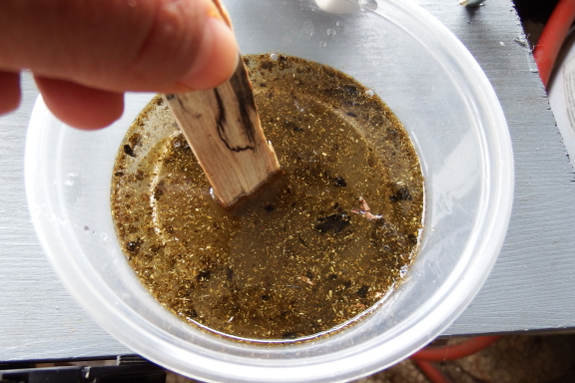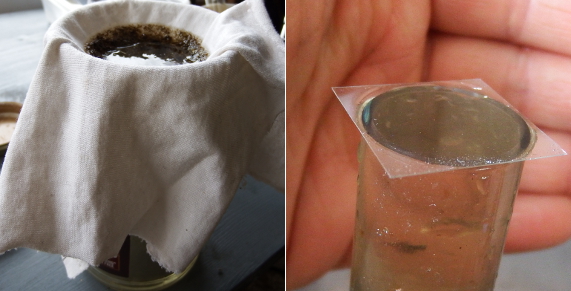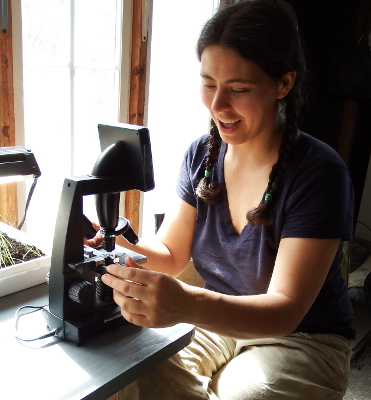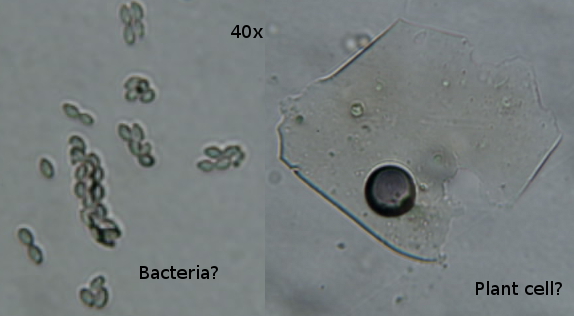
DIY goat poop worm analysis

As with our bees, I hate
the idea of pumping chemicals into our goats unless I'm positive they
have a problem with worms. The solution to this dilemma is what
scientists euphemistically refer to as a fecal exam and what I call a
goat poop analysis. Basically, you're looking for eggs of the parasitic
worms that give your herd such a hard time, then you use the number of eggs to decide whether to deworm.

"Okay, Anna. You just lost me," says the random reader. "How am I going to see microscopic worm eggs, let alone count them?"
 Well,
gentle reader, I'm glad you asked! It's pretty simple --- first you
follow your goat around staring at their butt until they poop. Next, you
gather three fresh pellets and mash them up in a solution of water
saturated with epsom salts. Then you strain out the non-microscopic gunk
using a clean rag and pour the remaining liquid into a test tube. Fill
the tube to the brim with a bit more of your epsom-salt solution, place a
cover slip on top so it's fully touching the liquid, wait 20 minutes,
and the worm eggs should float to the surface and adhere to your cover
slip. Then it's just a matter of examining the resulting slide under a
microscope to see if you find any worm eggs.
Well,
gentle reader, I'm glad you asked! It's pretty simple --- first you
follow your goat around staring at their butt until they poop. Next, you
gather three fresh pellets and mash them up in a solution of water
saturated with epsom salts. Then you strain out the non-microscopic gunk
using a clean rag and pour the remaining liquid into a test tube. Fill
the tube to the brim with a bit more of your epsom-salt solution, place a
cover slip on top so it's fully touching the liquid, wait 20 minutes,
and the worm eggs should float to the surface and adhere to your cover
slip. Then it's just a matter of examining the resulting slide under a
microscope to see if you find any worm eggs.
(Yes, I glossed over a lot of factors in that paragraph. This website contains the most scientific and, at the same time, home-user friendly explanation I've run across.)
The biggest problem I've
had with this experience so far is the obvious --- the watched goat
never poops. The easiest way to get your goat to defecate on command is
to wait until she stands up. The trouble is, Artemesia is such a people
pleaser, she jumps to her feet as soon as I step out the door. So I did
finally get some pellets Thursday....but they came from Abigail.

I figured I'd go ahead and try my hand at analysis anyway, even though Abigail's not the one I'm worried about. So I wasn't surprised that I didn't find anything I was sure were worm eggs. (This site
has some good images of various goat intestinal parasites. But,
basically, you're looking for ovals with circles inside.) Instead, I
mostly found lots of debris, one colony of what I think is probably
bacteria, and a few of what I think are probably plant cells that didn't
get entirely digested.
Now I just need to watch
Artemesia's butt a little longer and see what I find in her poop. In the
meantime, I've increased her concentrates in case she's anemic because
of growing kids instead of intestinal parasites. And I'm also taking the
time to sit with her while she eats so Abigail can't bully our first
freshener out of the last of her ration. Here's hoping by the time I
catch some fresh pellets from our darling doeling, Artie will be in peek
health and my anemia scare will be a thing of the past.
Want more in-depth information? Browse through our books.
Or explore more posts by date or by subject.
About us: Anna Hess and Mark Hamilton spent over a decade living self-sufficiently in the mountains of Virginia before moving north to start over from scratch in the foothills of Ohio. They've experimented with permaculture, no-till gardening, trailersteading, home-based microbusinesses and much more, writing about their adventures in both blogs and books.
Want to be notified when new comments are posted on this page? Click on the RSS button after you add a comment to subscribe to the comment feed, or simply check the box beside "email replies to me" while writing your comment.

Unless you're using distilled water, you might consider analysing a sample of your water as a baseline.
Otherwise how can you be sure that what you see comes from the goat poop?
Surely creek or well water has bacteria in it.
pedro --- Sorry to be a slowpoke about answering! I agree, the LCD display is awesome and really takes the pain and suffering out of microscopy.
This is the microscope we bought. We like it a lot, although if I was going to buy now I'd search around and see if there's one that magnifies a bit more. I don't need higher magnification for goat worm eggs, but it would be handy if you're looking at bacteria.